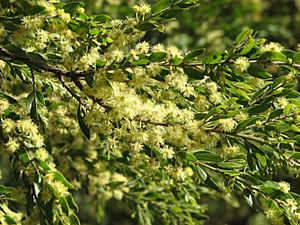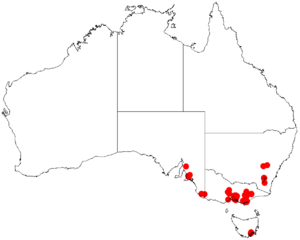Sticky wattle facts for kids
Quick facts for kids Sticky wattle |
|
|---|---|
 |
|
| Scientific classification | |
| Genus: |
Acacia
|
| Species: |
howittii
|
 |
|
| Occurrence data from AVH | |
| Synonyms | |
|
|
Acacia howittii, often called sticky wattle or Howitt's wattle, is a special tree or shrub. It grows only in Victoria, Australia. This means it is endemic to that area, found nowhere else naturally.
What Does Sticky Wattle Look Like?
This plant can be a shrub or a tree. It can grow quite tall, up to 9 meters (about 30 feet) high. Its branches are slender and often hang down.
Like many wattle plants, it doesn't have true leaves. Instead, it has flattened stems called phyllodes. These phyllodes are dark green and can be up to 2 centimeters (about 0.8 inches) long. They are thin and shaped like narrow leaves.
In October (which is spring in Australia), the sticky wattle gets small, round, pale-yellow flowers. These flowers grow in groups of 12 to 20. After the flowers bloom, long, straight seed pods form. These pods can be up to 6 centimeters (about 2.4 inches) long and are brown. Inside, they hold shiny, dark brown seeds. Each seed is about 3 to 4 millimeters long and has a small, fleshy cap called an aril.
Naming the Sticky Wattle
The sticky wattle was first officially described in 1893. This was done by Ferdinand von Mueller, who was a government botanist in Victoria. He named the plant after Alfred William Howitt, who collected the plant samples.
For a short time in 2003, the plant was given a different scientific name, Racosperma howittii. However, by 2006, it was moved back to its original genus Acacia.
Sometimes, Acacia howittii can mix with another wattle, Acacia leprosa. When this happens, they can create a new plant that is a hybrid of the two.
Where Does Sticky Wattle Grow?
This wattle naturally grows in eastern Victoria, Australia. You can find it from the Macalister River area near Mount Howitt in the north, down to Yarram in the south. It also extends east to places like Tabberabbera. It usually prefers to grow in moist forest areas.
Even though it's considered a rare plant in the wild, people often grow it in gardens. Because it's so popular, it has started to grow on its own in some areas outside its original home. This means it has become "naturalised" in those places.

